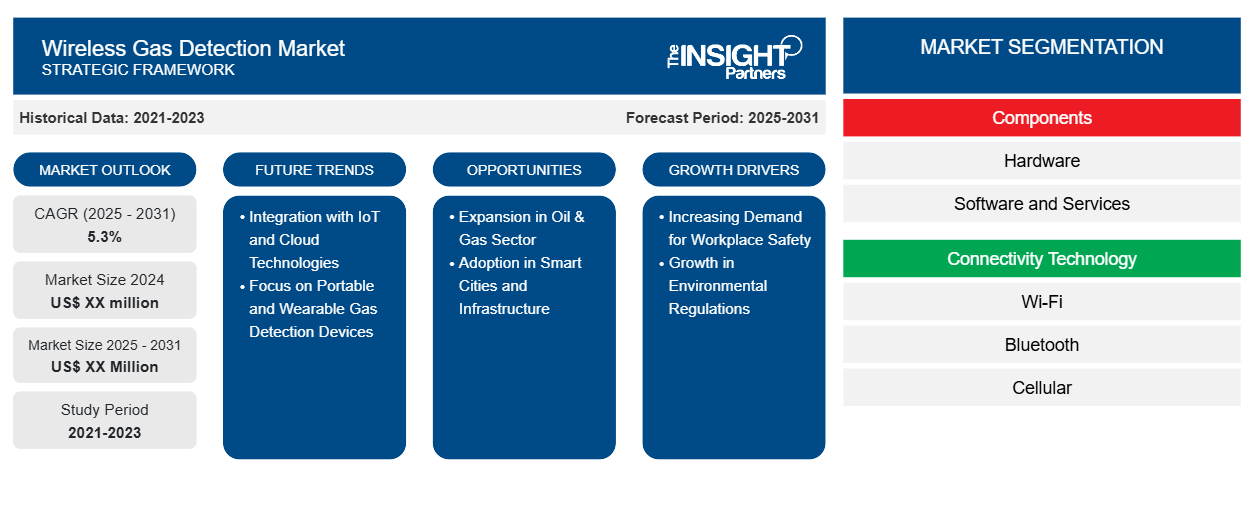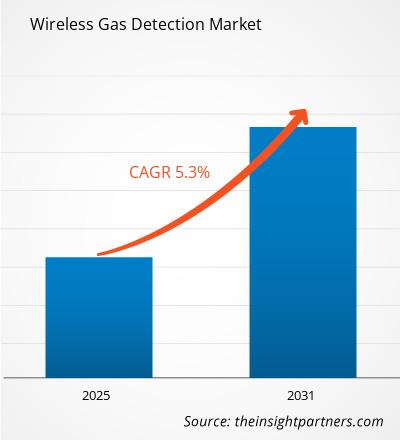The Wireless Gas Detection Market is expected to register a CAGR of 5.3% from 2025 to 2031, with a market size expanding from US$ XX million in 2024 to US$ XX Million by 2031.
The report is segmented by Components (Hardware, Software and Services), Connectivity Technology (Wi-Fi, Bluetooth, Cellular, and License-free ISM Band), Application (Industrial Safety, National Security and Military Applications, and Environmental Safety), End User (Oil & Gas, Chemical & Petrochemicals, Power & Utilities, Mining & Metals, Government & Military).The global analysis is further broken down at the regional level and major countries. The Report Offers the Value in USD for the above analysis and segments.
Purpose of the Report
The report Wireless Gas Detection Market by The Insight Partners aims to describe the present landscape and future growth, top driving factors, challenges, and opportunities. This will provide insights to various business stakeholders, such as:
- Technology Providers/Manufacturers: To understand the evolving market dynamics and know the potential growth opportunities, enabling them to make informed strategic decisions.
- Investors: To conduct a comprehensive trend analysis regarding the market growth rate, market financial projections, and opportunities that exist across the value chain.
- Regulatory bodies: To regulate policies and police activities in the market with the aim of minimizing abuse, preserving investor trust and confidence, and upholding the integrity and stability of the market.
Wireless Gas Detection Market Segmentation
Components
- Hardware
- Software and Services
Connectivity Technology
- Wi-Fi
- Bluetooth
- Cellular
- License-free ISM Band
Application
- Industrial Safety
- National Security and Military Applications
- Environmental Safety
End User
- Oil & Gas
- Chemical & Petrochemicals
- Power & Utilities
- Mining & Metals
- Government & Military
Customize This Report To Suit Your Requirement
You will get customization on any report - free of charge - including parts of this report, or country-level analysis, Excel Data pack, as well as avail great offers and discounts for start-ups & universities
Wireless Gas Detection Market: Strategic Insights

- Get Top Key Market Trends of this report.This FREE sample will include data analysis, ranging from market trends to estimates and forecasts.
Wireless Gas Detection Market Growth Drivers
- Increasing Demand for Workplace Safety: With growing awareness about workplace safety, especially in hazardous environments like manufacturing plants, oil and gas fields, and chemical industries, wireless gas detection systems are becoming essential. These systems provide real-time monitoring of gas levels, helping to detect leaks and prevent accidents such as explosions, fires, or toxic exposure. The increasing emphasis on employee health and safety regulations is driving the adoption of wireless gas detection technologies.
- Growth in Environmental Regulations: Stricter environmental regulations are pushing industries to adopt solutions that can monitor and mitigate hazardous gas emissions. Wireless gas detection systems enable continuous, remote monitoring of air quality and toxic gases in industrial settings, ensuring compliance with environmental standards. This driver is particularly strong in industries such as oil and gas, mining, and wastewater treatment, where gas emissions are a concern.
Wireless Gas Detection Market Future Trends
- Integration with IoT and Cloud Technologies: The trend of integrating wireless gas detectors with Internet of Things (IoT) platforms and cloud-based systems is gaining traction. These systems allow for real-time data collection, remote monitoring, and predictive analytics. By leveraging IoT, companies can get real-time alerts, view trends, and analyze gas concentrations from anywhere, improving safety and operational efficiency.
- Focus on Portable and Wearable Gas Detection Devices: There is a growing trend toward portable and wearable gas detection devices, particularly for workers in hazardous environments. These portable devices offer personal protection by alerting individuals to the presence of harmful gases such as carbon monoxide, methane, or hydrogen sulfide. The trend reflects the growing need for mobile solutions that enable workers to move freely while ensuring safety in dynamic environments.
Wireless Gas Detection Market Opportunities
- Expansion in Oil & Gas Sector: The oil and gas industry presents a significant opportunity for the wireless gas detection market. Given the inherent risks of gas leaks and explosions, the need for effective monitoring systems is critical. Wireless gas detection can improve monitoring in remote locations and offshore rigs, enhancing both worker safety and operational efficiency. The industry's focus on safety and compliance provides a growing market for these technologies.
- Adoption in Smart Cities and Infrastructure: With the rise of smart cities, there is an increasing demand for technologies that ensure public safety and environmental monitoring. Wireless gas detection systems can be integrated into smart city infrastructure for continuous monitoring of air quality and hazardous gases in public spaces, transportation systems, and industrial zones. This presents a promising opportunity for expanding the use of wireless gas detectors in urban settings.
Wireless Gas Detection Market Regional Insights
The regional trends and factors influencing the Wireless Gas Detection Market throughout the forecast period have been thoroughly explained by the analysts at Insight Partners. This section also discusses Wireless Gas Detection Market segments and geography across North America, Europe, Asia Pacific, Middle East and Africa, and South and Central America.

- Get the Regional Specific Data for Wireless Gas Detection Market
Wireless Gas Detection Market Report Scope
| Report Attribute | Details |
|---|---|
| Market size in 2024 | US$ XX million |
| Market Size by 2031 | US$ XX Million |
| Global CAGR (2025 - 2031) | 5.3% |
| Historical Data | 2021-2023 |
| Forecast period | 2025-2031 |
| Segments Covered |
By Components
|
| Regions and Countries Covered | North America
|
| Market leaders and key company profiles |
Wireless Gas Detection Market Players Density: Understanding Its Impact on Business Dynamics
The Wireless Gas Detection Market market is growing rapidly, driven by increasing end-user demand due to factors such as evolving consumer preferences, technological advancements, and greater awareness of the product's benefits. As demand rises, businesses are expanding their offerings, innovating to meet consumer needs, and capitalizing on emerging trends, which further fuels market growth.
Market players density refers to the distribution of firms or companies operating within a particular market or industry. It indicates how many competitors (market players) are present in a given market space relative to its size or total market value.
Major Companies operating in the Wireless Gas Detection Market are:
- Honeywell International, Inc.
- Drägerwerk AG & Co. KGaA
- Agilent Technologies, Inc.
- Sensidyne, LP
- United Electric Controls
Disclaimer: The companies listed above are not ranked in any particular order.

- Get the Wireless Gas Detection Market top key players overview
Key Selling Points
- Comprehensive Coverage: The report comprehensively covers the analysis of products, services, types, and end users of the Wireless Gas Detection Market, providing a holistic landscape.
- Expert Analysis: The report is compiled based on the in-depth understanding of industry experts and analysts.
- Up-to-date Information: The report assures business relevance due to its coverage of recent information and data trends.
- Customization Options: This report can be customized to cater to specific client requirements and suit the business strategies aptly.
The research report on the Wireless Gas Detection Market can, therefore, help spearhead the trail of decoding and understanding the industry scenario and growth prospects. Although there can be a few valid concerns, the overall benefits of this report tend to outweigh the disadvantages.
- Historical Analysis (2 Years), Base Year, Forecast (7 Years) with CAGR
- PEST and SWOT Analysis
- Market Size Value / Volume - Global, Regional, Country
- Industry and Competitive Landscape
- Excel Dataset


- Artificial Intelligence in Healthcare Diagnosis Market
- Electronic Shelf Label Market
- Pharmacovigilance and Drug Safety Software Market
- Neurovascular Devices Market
- Intraoperative Neuromonitoring Market
- Wind Turbine Composites Market
- Medical Second Opinion Market
- Bathroom Vanities Market
- Radiopharmaceuticals Market
- Smart Parking Market

Report Coverage
Revenue forecast, Company Analysis, Industry landscape, Growth factors, and Trends

Segment Covered
This text is related
to segments covered.

Regional Scope
North America, Europe, Asia Pacific, Middle East & Africa, South & Central America

Country Scope
This text is related
to country scope.
Frequently Asked Questions
Some of the customization options available based on the request are an additional 3-5 company profiles and country-specific analysis of 3-5 countries of your choice. Customizations are to be requested/discussed before making final order confirmation# as our team would review the same and check the feasibility
Advanced motherboard are likely to remain a key trend in the market.
Key players in the wireless gas detection market include Honeywell, 3M, Smiths Detection, General Monitors, Teledyne Technologies Incorporated, Emerson, GMI Gas Measurement Instruments, Draeger, Kimoto Electric Co., Ltd, and Figaro Engineering Inc.
Increasing need for safeguarding industries with advanced safety measures and need to improve on-site safety are the major factors driving the wireless gas detection market.
The Wireless Gas Detection Market is estimated to witness a CAGR of 5.3% from 2023 to 2031
Trends and growth analysis reports related to Electronics and Semiconductor : READ MORE..
1. Honeywell International, Inc.
2. Drägerwerk AG & Co. KGaA
3. Agilent Technologies, Inc.
4. Sensidyne, LP
5. United Electric Controls
6. Siemens AG
7. Tyco Gas and Flame Detection
8. Yokogawa Electric Corporation
9. RAE Systems, Inc.
10. Pem-Tech, Inc.

 Get Free Sample For
Get Free Sample For